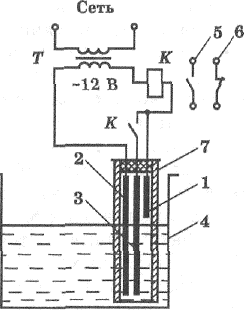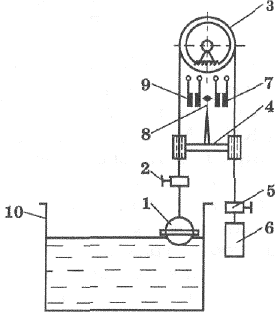Level sensors, level measuring devices
Level sensors serve to control the liquid level in the tanks and signal the regulation of this level.
The level sensors are:
1. electrode
2. float
3. membrane
On a functional basis, level meters are divided into:
-
level meters — devices that continuously monitor the level;
-
signaling devices — devices that discretely respond to one or more specified levels.
Electrode level sensor
An electrode level sensor is used to monitor the level of electrically conductive liquids. It has a short 1 electrode and two long 2, 3, which are fixed in the terminal box. The short electrode is the contact of the upper level of the liquid and the long electrode is the contact of the lower level. The sensor is connected to the pump motor control station. When the water touches the short electrode, it will activate the pump starter. A drop in the water level when it falls below the long electrode gives the command to turn on the pump.

Figure Schematic diagram of an electrode level sensor
The sensor electrodes are included in the circuit of the coil of the intermediate relay K, which is connected to the secondary winding of the step-down transformer with a voltage of 12 V. When the liquid level in the tank rises to the level of short electrode 1 , an electrical circuit is formed: the secondary winding of the transformer — relay coil K — electrode 1 — liquid — electrode 2. The relay is actuated and self-energized through its contact K and electrode 3, while contacts 6 of the relay give the command to turn off the pump motor. When the liquid level drops, when it falls below the level of electrode 3, the relay turns off and turns on the pump motor.
Float level sensor

Rice. Float Level (Relay)
The measurement of the level of viscous and inhomogeneous media is carried out by means of float and displacement level meters. A floating level sensor (relay) is used in heated rooms to control the level of non-aggressive liquids. The figure shows a schematic diagram of the relay. Float 1 is immersed in the tank 10, suspended on a flexible contact through block 3 and balanced with a weight 6. Brakes 2 and 5 are attached to the contact, which at the limiting levels of liquid in the tank rotates the rocker arm 4 of the contact device 8. At turning the rocker arm closes contacts 7 or 9, respectively, which enable or disable the pump motor.
Diaphragm level sensors
To determine the level of bulk materials in the containers, membrane level sensors are used, which are installed in the hole in the wall of the hopper. In them, the membrane acts on the contacts, closing or opening the control circuit of the loading and unloading devices.
More on this topic: Level control devices in industrial automation systems
